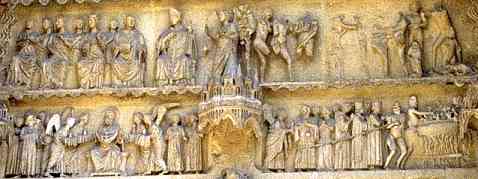


If you are looking at this page without frames, there is more information about medieval writing to be found by going to the home page (framed) or the site map (no frames).
| New Testament Apocrypha (4) | |
| One of the last books to be universally accepted into the canon of the New Testament was the Revelation of St John, also referred to as the Apocalypse, the last book of the Bible, which prefigures the events of the end of the world and the Last Judgement. It is, perhaps, not surprising that this text might have caused some concern. At one level, with its tumble of words and crazy imagery, it would appear to have been written by someone who had been sitting for too long in the hot sun, inhaling or ingesting something that is not good for your health. At another level, scholars tell us that it contains among its epic battle imagery, references to historical conflicts that were so distant at the time of writing that they had passed from sober history into heroic legend. What it does not do is provide any overt, didactic moral message as to how one should behave on this earth in order to come out on the right side of things at the end. The Book of Revelation did provide some stunning imagery in medieval art, but a little something was missing. |  |
| A 15th century stained glass panel depicting the woman clothed with the sun, one of the many enigmatic characters from the Book of Revelation, from the parish church of St Michael Spurriergate in York. | |
| Some other apocalyptic texts gave exceedingly precise details of the nature of the torments of hell, with particular and appropriate punishments for each kind of sin. These relied on the deficiency of human imagination to imagine perpetual torment that did not involve bodily pain. These texts provided material for the mighty Last Judgement panels which appear in carved form above the tympana of cathedrals and great churches in France, or in painted form on the chancel arches of churches in England. Only fragmentary remains of these last have survived, but they must have provided a terrifying image for the laity in the nave of the church as they listened to the sounds of the mass emanating from the enclosed and secret anclave of the chancel. | |
 |
|
| A Last Judgement panal on a tympanum at Rheims Cathedral. | |
 |
|
| The faded relics of a Last Judgement painting, or Doom, above the chancel arch of Little Shelford church, Cambridgeshire. | |
| Of course, in the 14th century a chap called Dante did his own take on the theme of appropriate punishments in hell, fully aware of the exisiting tradition in the church. | |
| The New Testament Apocrypha comprise, therefore, a variety of texts, some with their origins in very early Christian times, some elaborated during the course of the middle ages. They were not hidden or secret, but part of the official traditions of the church, legitimately expressed in art and through the medium of church drama. The Mystery Plays may have been performed by the laity, but they were undoubtedly written and approved by authorities in the church, and they drew on these texts for performance in non-liturgical contexts. | |
| The transmission of the texts is also fascinating. They were not simply copied verbatim through multiple generations, like the Bible, but went through many transformations along the way. Stories were selected and combined. They were included in other types of works. They were embellished. They appeared in new forms of compilation. In fact, I'm not entirely sure that anyone knows exactly how the full process of transmission occurred in detail. Their function was not only to fill in the gaps in the New Testament, although this they did, but also to illustrate and exemplify certain Christian virtues. It is, perhaps, not surprising that they appear in profusion, both in imagery and in performace, during the heyday of the preaching orders. Philosophy and exegesis is for scholars; the laity need stories. | |
If you are looking at this page without frames, there is more information about medieval writing to be found by going to the home page (framed) or the site map (no frames). |
|